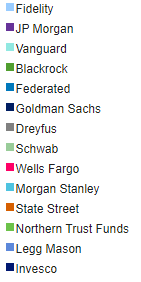
Mega U.S. Banks Encounter Liquidity Dilemma over Glut of Cash Deposits
Posted on 06/10/2021
As deaths mounted, the coronavirus (COVID-19) pandemic took nearly everyone by surprise and in early 2020 the U.S. federal government under then President Donald Trump acted quickly to flood the American economy with a bazooka of liquidity, while growing the balance sheet of the Federal Reserve. At the onset of the pandemic lockdowns, U.S. companies started to hoard cash and reduce expenditures. In March 2020, the Fed dropped interest rates to near zero and started a bunch of bond buying programs. These QE measures enabled corporations to raise capital at a very low cost. In fact, the U.S. Department of Treasury tapped its Exchange Stabilization Fund to capitalize a number of credit facilities. Debt was easy to take from bond investors, while bank debt wasn’t as attractive.
Facing panic as COVID gene therapy vaccines were being tested at this time under Operation Warp Speed, U.S. corporations started to hoard cash by raising debt from investors, cutting costs, and restructuring operations. In the aggregate, with more money printing and corporate discipline, U.S. companies started to increase their bank deposits without taking more bank loans in the aggregate.
Lower Net Interest Margin on Average
Banks love big deposits, as long as they can use the money to make loans. However, bank lending slowed down big-time as large corporations were able to tap yield-hungry investors at lower interest rates. Some bank executives tiptoed and asked some clients to either take out some loans, spend the cash, go to other smaller banks, or slow down their deposits. Federal Reserve data shows that total loans equaled 61% of all deposits as of May 26, 2021 down from 75% in February 2020. Banks measure revenue success with a metric called net interest margin. Simply put, net interest margin is a measure of the difference between the interest income generated by banks and the amount of interest paid out to their lenders, relative to the amount of their assets. According to the Federal Deposit Insurance Corporation, net interest margin fell to a record low in the first quarter of 2021. Don’t feel sad for all the banks, some had record profits in the first quarter of 2021 from non-interest income from activities such as equity trading, IPOs, and even the creation of SPACs. In an even brighter scenario for banks, if and when interest rates go up, they are positioned to do better on the loan margin part of the revenue equation.
“The banking industry reported positive results for the first quarter of 2021, reflecting optimism about the pace of the economic recovery. However, a record low net interest margin and slow loan growth could challenge banks going forward,” Chairman Jelena McWilliams said in a recent periodic report by the FDIC.
As these companies expanded their cash pots, some have been willing to invest in money market funds, fund investments, and even Bitcoin like Tesla, Inc., Square, and Microstrategy. The majority of large U.S. corporate CFOs were conservative in cash, even opting to not maximize yield, but liquidity. Many large U.S. companies moved to operated with a higher cash balance for nearly 1 year.
This is cause and effect time now. Larger banks have to deal with a rule for them to hold capital equivalent to at least 3% of all assets. The Federal Reserve temporarily excluded reserve balances and U.S. Treasury securities from the denominator of the supplementary leverage ratio (SLR) in April 2020 knowing the incoming flood of money would impact banks. In March 2021, that regular ratio calculation came back to its original formula. Thus, banks warned regulators that growing cash deposits with lower loans could force them to raise more capital or say no to deposits.
Put Your Money in Money Market Funds
In late 2020, large bank executives initiated talks with large corporate clients to move stale-cash funds from deposits to money market funds. Money market fund assets are treated differently under bank capital rules, alleviating some of the regulatory pressure for banks in their capital requirements. According to the Investment Company Institute, flows into U.S. money market funds surged in 2021 putting total assets to US$ 4.61 trillion, just a bit less than record set in May 2020. The flow of money into money market funds has cause these funds to find new places to move that new cash. Due to very low interest rates, money market funds have been storing the cash back at the Federal Reserve overnight in a facility that pays them zero return and had been largely ignored for the past three years. Intended on being temporary, the Federal Reserve formed the overnight reverse repurchase agreement facility (ON RRP) in 2014 to improve its control of the federal funds rate, the interest rate banks and government-sponsored enterprises charge each other for unsecured and mostly overnight loans. Funds stored overnight with the Federal Reserve Bank of New York surged in May 2021 and hit a record of US$ 497.4 billion. Some analysts think the number could swell to US$ 1 trillion.
Total investments by each category of U.S. MMF

Sources: SEC Form N-MFP2, OFR Analysis
LINK: https://www.financialresearch.gov/money-market-funds/
Note: All data presented are OFR-derived aggregates on an ultimate parent basis of the original source data. Updated May 18, 2021 with data through April 30, 2021.
Keywords: Federal Reserve System.



